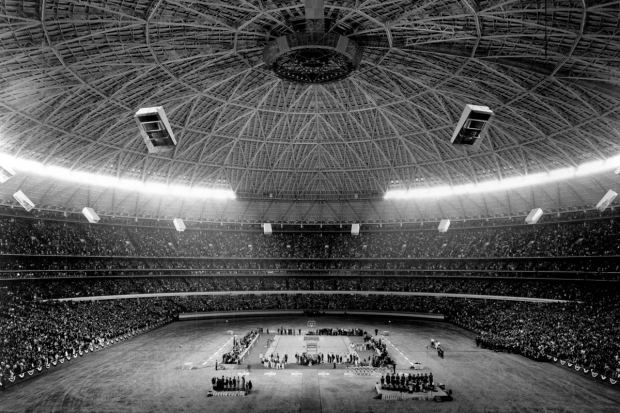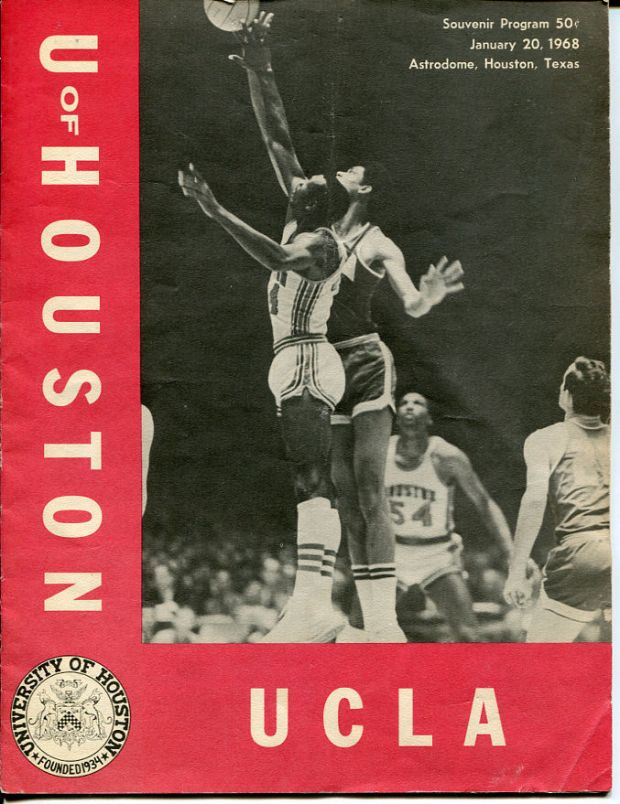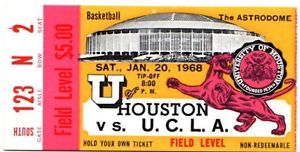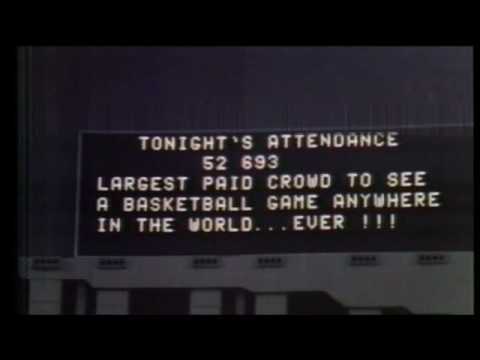

He was playing with a scratched cornea, but what Kareem Abdul-Jabbar saw in the Houston Astrodome is still clear in his mind 50 years later.
The court was a speck in the vast stadium. When he looked across from the sideline, UCLA’s All-American center saw the stands, where a record-setting 52,693 packed the first domed sports stadium in the world to catch a glimpse of the two best teams in college basketball.

When he looked across the baseline, it was “nothingness” behind the court.
Also, wherever he looked, he saw Elvin Hayes.
The two All-Americans battled in a made-for-TV spectacle that changed college basketball on Jan. 20, 1968. It was the No. 1 Bruins against the No. 2 Cougars, a rematch of the undefeated teams that met in the 1967 NCAA semifinal that UCLA won by 15 points.
It was in the Astrodome, a marvel in modern architecture at the time, in front of the largest crowd to watch a live basketball game in the world to that point. It was the first college basketball game televised nationally live in prime time.
It was dubbed the “Game of the Century.”
And with a dramatic 71-69 Houston victory that snapped UCLA’s 47-game winning streak, it lived up to the hype.
“It was unusual; it was brand new, and that showed there was an interest in college basketball nationally,” said Ron Rapoport, a sports writer who collaborated with broadcasting pioneer Eddie Einhorn on the book “How March Became Madness: How the NCAA Tournament Became the Greatest Sporting Event in America.”
“It all took off from there.”
On the game’s 50th anniversary, its legacy remains ubiquitous, manifested in every new basketball training facility and nationally televised marquee matchup.
BIG STAGE
Abdul-Jabbar, then known as Lew Alcindor, didn’t realize the future impact of the strange game. It didn’t hit him until he retired from the NBA two decades later and noticed how every national championship game was broadcast nationally and the tournament had expanded to 64 teams.
“When I played in high school, March Madness was just for hoops nuts,” he said this week. “It had a really rabid following among the people that were into it, but now the whole idea of it has burst through the walls.”
Excitement for the game intensified as the Bruins and Cougars were both undefeated. The game was locally in L.A. on KTLA-Channel 5, but in Westwood, UCLA hosted a viewing party in Pauley Pavilion. It was a packed house, long-time UCLA fan Ron Friedman remembers. The only problem was that they never got to watch the game.
Fans were refunded their money after technical difficulties prevented the broadcast from ever making it to the big screen. Friedman listened to the rest of the game on the radio after leaving early.
“No one at the time knew how college basketball was growing and changing,” Friedman said. “We just knew UCLA was the best team in the country and we didn’t think anyone could ever play with UCLA.”
On that day 50 years ago, Houston could.
 Eight days after scratching his cornea against Cal, Abdul-Jabbar was one of four UCLA starters to play all 40 minutes. He made just 4 of 18 shots, one of the worst shooting games of his illustrious Bruins tenure.
Eight days after scratching his cornea against Cal, Abdul-Jabbar was one of four UCLA starters to play all 40 minutes. He made just 4 of 18 shots, one of the worst shooting games of his illustrious Bruins tenure.
Hayes, meanwhile, had the game of his career with 39 points and 15 rebounds. UCLA’s last chance for a possible tying basket was deflected out of bounds by Michael Warren before the ball could reach Lynn Shackelford’s waiting hands in the corner.
UCLA’s dominance was over. Fans tried to storm the court, running from their seats more than 100 yards away and leaping over trenches that were dug for court-side reporters and TV announcers.
Play-by-play announcer Dick Enberg, then the up-and-coming voice of the Bruins who passed away last month, said it was “like the return of the Alamo.”
BIG MONEY
TV networks flocked to college basketball just as quickly in the aftermath of the wildly successful game.
NBC picked up the NCAA Tournament in 1969 after the event had only been broadcast regionally in the prior years. With the TV networks on board, college basketball suddenly became a revenue sport.
“College basketball really fed off of television and television really fed off of college basketball,” UCLA economics professor Lee Ohanian said. “It was really a perfect synergy.”
For the Game of the Century, Einhorn flew across the country pitching the game to individual stations, 120 total. The networks were furious when the stations cancelled their regular-scheduled programming.
Then in 2016, CBS and Turner Sports paid $8.8 billion for rights to broadcast the NCAA Tournament through 2032. Every game is televised live. There are multiple vantage points available online. The field has expanded from 23 teams in 1968 to 68.
A similar influx of revenue for the NBA from a 2014 TV deal resulted in a sudden boost to the salary cap in 2016. That summer, non-all-star free agents signed record-breaking deals.
The NCAA, limited by its amateur athletics mantra, puts its money in other places.
In 2017, Louisville’s Rick Pitino and Kentucky’s John Calipari had salaries worth more than $7 million, according to USA Today. Oregon State used $4 million in university revenue bonds to partially fund its basketball practice facility that opened in 2013. Revenue from football and men’s basketball, often the only two revenue-producing sports at universities, subsidizes other Olympic sports.
“Ironically, at the end of the day, it’s supposed to be about amateur athletics, but recruiting comes down to the spending of dollars,” Ohanian said. “It doesn’t go into the pocket of the athlete, but it’s indirect and it ends up making a big, big difference.”
BIG COMPETITON
 John Wooden was apprehensive about playing Houston in 1968. It was going to be a spectacle, too garish for the legendary coach’s famous business-like approach. And it was going to be a tough opponent in the non-conference season.
John Wooden was apprehensive about playing Houston in 1968. It was going to be a spectacle, too garish for the legendary coach’s famous business-like approach. And it was going to be a tough opponent in the non-conference season.
“He wanted to play patsy teams he could beat,” Rapoport said of Wooden’s nonconference scheduling philosophy.
Yet Wooden bowed to UCLA athletic director J.D. Morgan, who understood the game’s role in growing the sport.
The appeal of UCLA’s star-studded regular-season matchup paved the way for more of the marquee games required to make the cut for an NCAA Tournament bid now. Wooden’s Bruins played 24 nonconference teams ranked in the AP Poll in the 19 seasons leading up to their matchup with Houston in 1968. During the final seven years of his UCLA tenure, the Bruins faced 14 ranked foes.
The premiere regular-season matchups boost college basketball as an entertainment good, Ohanian said, as sports require two high-performing teams that are evenly matched to reach their peak quality.
UCLA and Houston fit the bill.
Each school received $125,000 for the event, according to the Houston Chronicle, four times more than the payout for the NCAA tournament that spring. That sum seems more and more like a bargain as the years progress.
“The UCLA-Houston game kind of fast-forwarded college basketball by at least 10 years and consequently created a lot more revenue,” Ohanian said. “I think neither UCLA nor Houston was adequately compensated for doing that favor for the rest of college basketball, but they certainly did.”
UCLA got its on-court revenge for the loss two months later in the NCAA semifinal when the Bruins, with a healthy Alcindor, crushed the Cougars 101-69. UCLA then added its fourth of 10 national championships and what would be the second of seven straight.
“People were tired of UCLA winning so much,” Abdul-Jabbar said. “We had won three of the previous four NCAA tournaments and needless to say, it got even worse for everybody if that was what their problem was.
MORE:
* AP Photos from the game
* Where are they now? A retrospective blog GameOfTheCentury.blogspot.com
* A look at the CBSSN special “History in the Astrodome 1968: UCLA vs. Houston” that will reair Saturday at 6 p.m., Sunday at 3 p.m., Monday at 6 p.m. and Thursday at 8 p.m.





